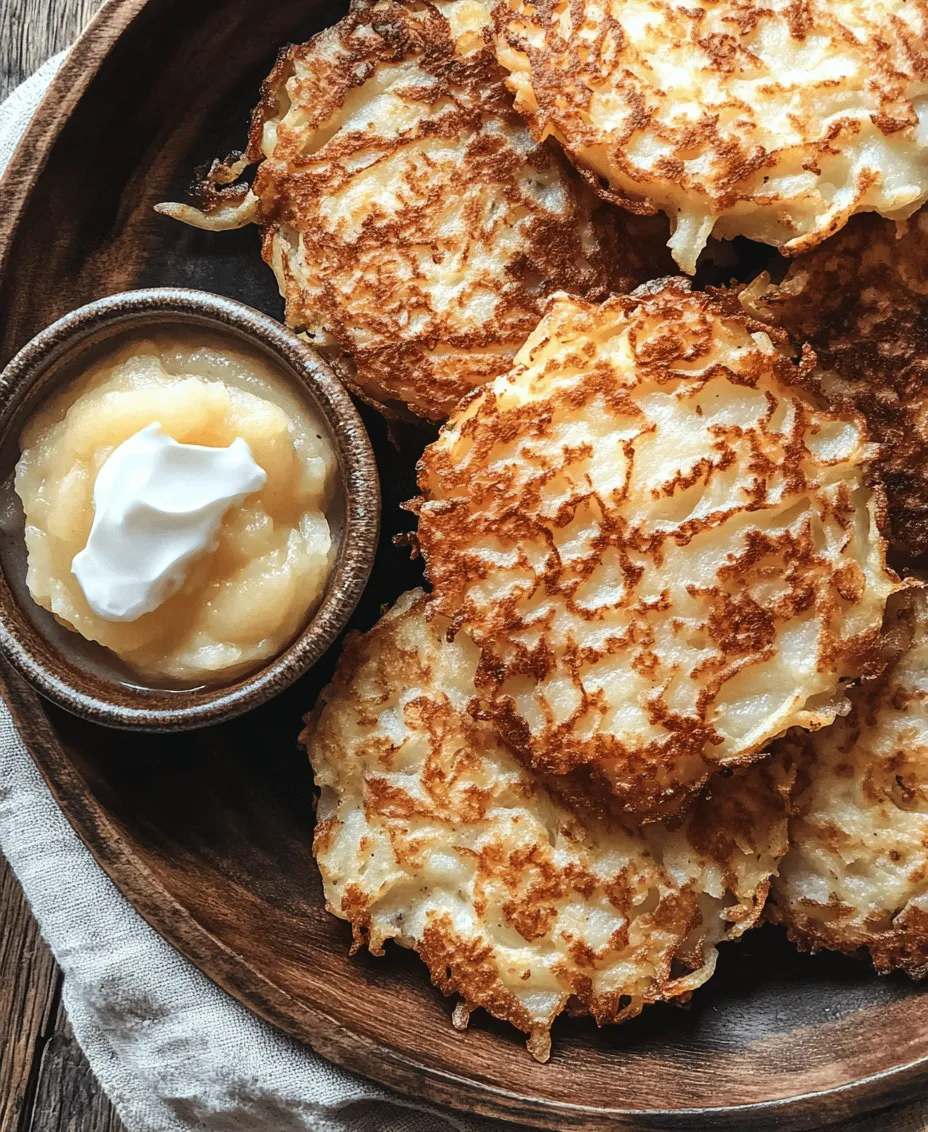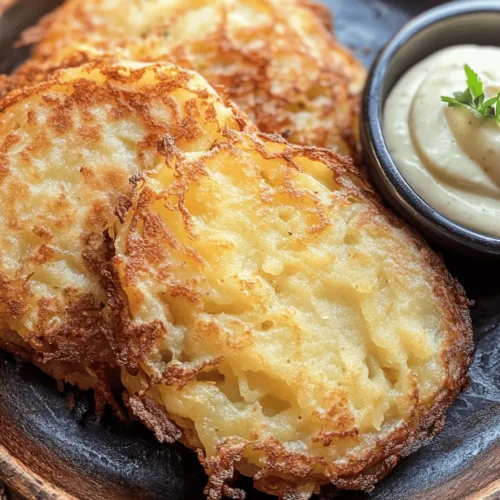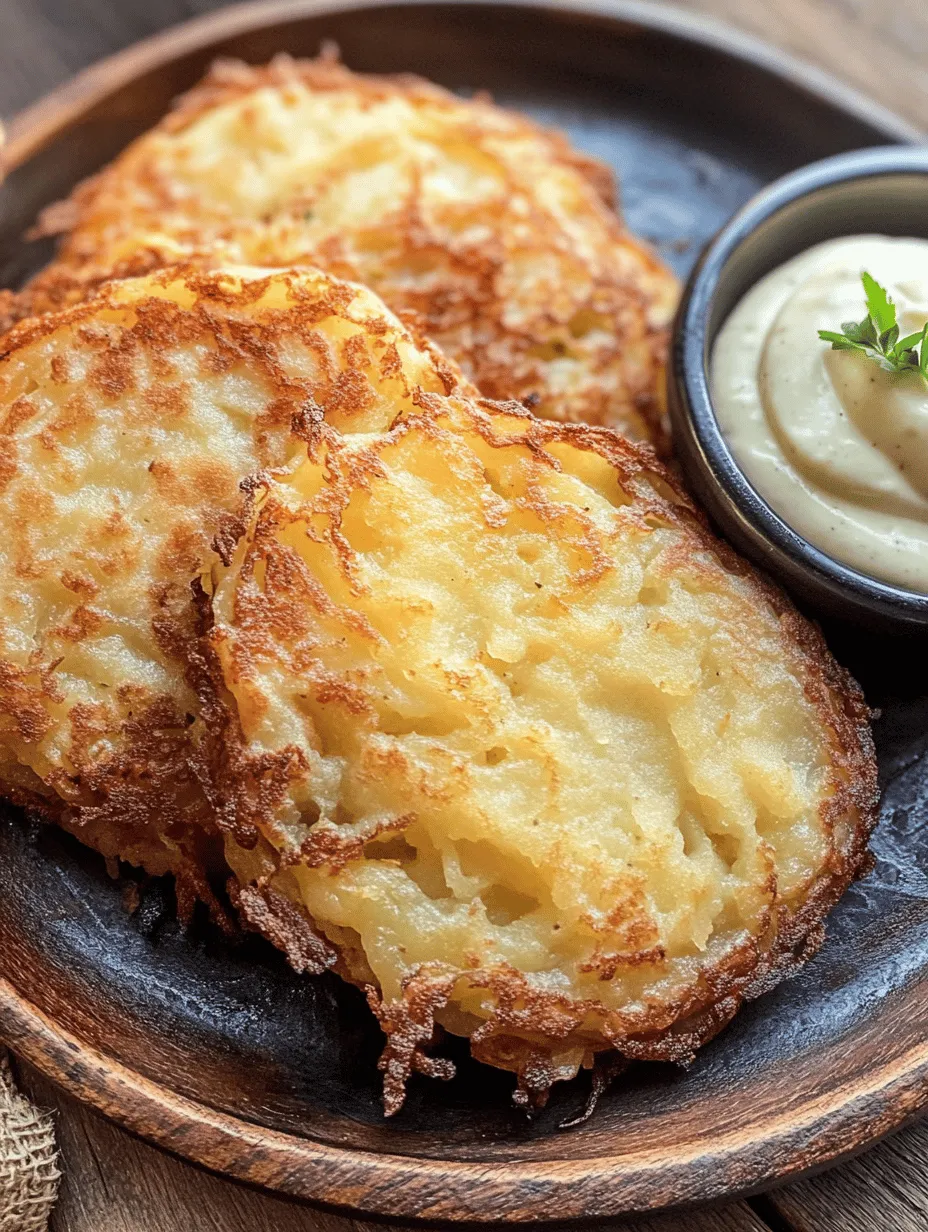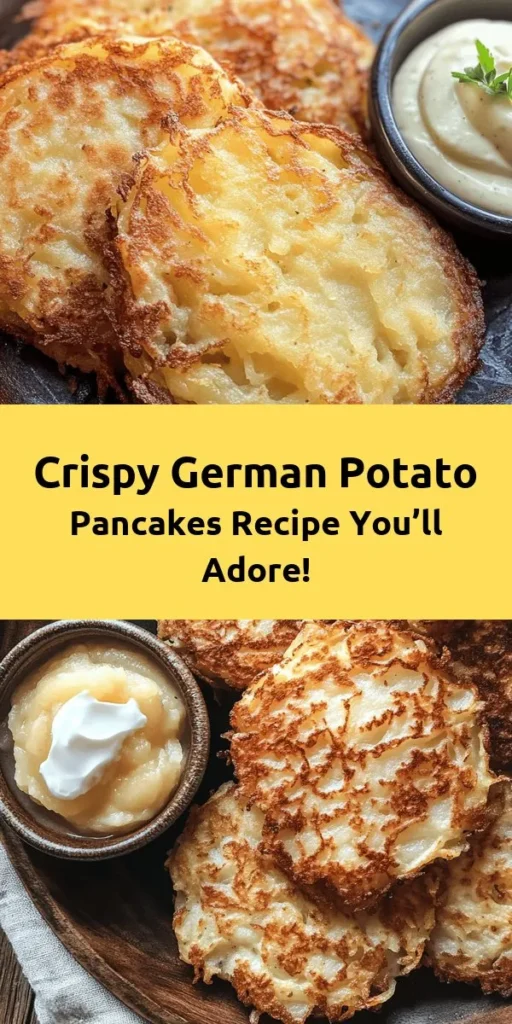Introduction: The Heart of German Cuisine
German cuisine is a treasure trove of hearty, comforting dishes that reflect the country’s rich cultural heritage. Among the most beloved of these dishes is the crispy potato pancake, known as “Reibekuchen” or “Kartoffelpuffer.” These delightful golden-brown treats are not just a staple in German households; they are also a quintessential feature at festive markets and family gatherings, capturing the essence of comfort food that warms the heart and soul.
The popularity of potato pancakes extends beyond mere taste; they embody a sense of tradition and celebration. Whether enjoyed as a side dish, a snack, or a main course, crispy potato pancakes offer a versatile option that can please any palate. In this article, we will delve into the rich history behind German potato pancakes, share an authentic recipe, and explore the techniques that ensure your pancakes turn out perfectly crispy every time.
The History of German Potato Pancakes
Understanding the cultural significance of potato pancakes in Germany provides a deeper appreciation for this dish, which has evolved over the centuries to become a beloved specialty.
Origin and Evolution of Kartoffelpuffer
The origins of Kartoffelpuffer date back to the 18th century, when potatoes were introduced to Europe from South America. At first, potatoes were viewed with skepticism, but they quickly became a staple food in many regions, including Germany. The humble potato gave rise to numerous traditional dishes, among which the potato pancake stands out.
Historically, Kartoffelpuffer were often made from leftover mashed potatoes, a practice that reflects the resourcefulness of the German people. As the recipe evolved, grated raw potatoes became the preferred method, allowing for a crispier texture and a more appealing presentation. Today, the dish is enjoyed by families across Germany and has garnered international recognition, becoming a symbol of German comfort food.
The Role of Potato Pancakes in German Festivals and Celebrations
In Germany, potato pancakes are more than just a meal; they are a cultural phenomenon often associated with festivals and celebrations. During the festive season, particularly around Christmas markets, vendors serve up freshly made Kartoffelpuffer, attracting crowds with their tantalizing aroma and irresistible crunch.
These pancakes are typically served with a variety of toppings, such as applesauce, sour cream, or even smoked salmon, allowing for a delightful blend of flavors and textures. In many German households, potato pancakes are a traditional dish for family gatherings and celebrations, symbolizing togetherness and comfort during special occasions.
Regional Variations Across Germany
While the basic concept of Kartoffelpuffer remains consistent across Germany, regional variations add unique twists to the classic recipe. In the Rhineland, for example, you might find potato pancakes enriched with grated carrots or zucchini, providing an interesting flavor profile. In Bavaria, they may be served with savory toppings like sauerkraut or crispy bacon.
Each region of Germany brings its own culinary flair to the dish, making potato pancakes a versatile option that can be easily adapted to suit local tastes and ingredients. Whether you are in a bustling city or a quaint village, you are sure to find a version of Kartoffelpuffer that reflects the local culture and traditions.
Ingredients for Authentic German Potato Pancakes
A successful potato pancake hinges on the quality and balance of its ingredients. Below is an overview of the key components needed to create authentic German potato pancakes.
Overview of Key Ingredients
To make the perfect Kartoffelpuffer, you will need the following primary ingredients:
– Potatoes: The star of the dish, providing flavor and texture.
– Onions: Enhancing the overall flavor profile of the pancakes.
– Eggs: Acting as a binding agent to hold the mixture together.
– Flour and Baking Powder: Contributing to the desired texture and crispiness.
– Seasonings: Including salt, pepper, and optional nutmeg for added depth of flavor.
Potatoes: Types and Characteristics
When it comes to selecting potatoes for your pancakes, choosing the right type is crucial. Starchy potatoes, such as Russets or Idaho potatoes, are ideal for making crispy pancakes due to their high starch content. These varieties create a light and airy texture while maintaining a deliciously crisp exterior.
Alternatively, you can also use waxy potatoes, like Yukon Gold, which have a slightly different texture. However, the best results are often achieved by using a combination of both types, allowing for a balance of creaminess and crispiness in your pancakes.
Onions: Enhancing Flavor
Onions play a vital role in enhancing the flavor of potato pancakes. Grated onions add a subtle sweetness and depth, complementing the earthy flavor of the potatoes. For a more pronounced onion taste, consider using a combination of yellow and red onions.
The key is to finely grate the onions so that they integrate smoothly into the potato mixture, ensuring that every bite is infused with their aromatic flavor.
Eggs: Binding the Mixture
Eggs are essential in binding the ingredients together, providing structure and stability to the pancake mixture. They help to ensure that your pancakes hold their shape during cooking and do not fall apart in the frying pan.
Using large eggs is generally recommended, and it’s best to add them after grating the potatoes and onions to create a cohesive mixture.
Flour and Baking Powder: Achieving the Perfect Texture
Flour is a critical ingredient that helps to absorb moisture from the potatoes and onions, contributing to the desired texture of the pancakes. All-purpose flour is typically used, but you can also experiment with alternatives like chickpea flour for a gluten-free option.
Adding a small amount of baking powder can help to lighten the batter, creating a fluffier pancake. However, be careful not to overdo it, as too much baking powder can alter the flavor and texture of the pancakes.
Seasonings: Salt, Pepper, and Optional Nutmeg
The seasoning of your potato pancake mixture is vital for achieving a well-rounded flavor. A generous pinch of salt and freshly ground black pepper is essential, as these ingredients enhance the natural taste of the potatoes and onions.
For a unique twist, consider adding a hint of nutmeg. This warm spice can elevate the flavor profile and provide a comforting aroma that pairs beautifully with the potatoes.
The Importance of Fresh Ingredients
Using fresh, high-quality ingredients is key to achieving the best results in your potato pancakes. Freshly grated potatoes and onions ensure that your pancakes have the right moisture content and flavor. Aim to use ingredients that are in season or locally sourced, as this will enhance the overall taste and texture of your dish.
Preparation Steps for Perfect Crispy Potato Pancakes
Now that you have a solid understanding of the ingredients, it’s time to dive into the preparation steps that will ensure your potato pancakes are crispy on the outside and tender on the inside. Follow these detailed instructions for the best results.
1. Prepare the Potatoes and Onions: Begin by peeling the potatoes and rinsing them under cold water to remove excess starch. This step is crucial for achieving maximum crispiness. Use a box grater or a food processor fitted with a grating attachment to grate the potatoes and onions. Place the grated mixture in a clean kitchen towel or cheesecloth and squeeze out as much liquid as possible. This will help prevent sogginess in the final pancakes.
2. Combine the Ingredients: In a large mixing bowl, combine the grated potatoes and onions. Add the eggs, flour, baking powder, salt, pepper, and nutmeg (if using). Mix everything together until well combined, ensuring that the potatoes are evenly coated with the flour and egg mixture.
3. Heat the Oil: In a large skillet or frying pan, heat a generous amount of oil over medium-high heat. You want enough oil to cover the bottom of the pan, allowing the pancakes to fry evenly. A combination of vegetable oil and clarified butter works well for achieving a crispy exterior without burning.
4. Form the Pancakes: Once the oil is hot, use a spoon or your hands to portion out the potato mixture. Shape each portion into a flat, round pancake about 1/2 inch thick. Avoid overcrowding the pan, as this can lower the temperature of the oil and result in greasy pancakes.
5. Fry Until Golden Brown: Carefully place the formed pancakes in the hot oil and fry for about 3-4 minutes on each side, or until they are golden brown and crispy. Adjust the heat as necessary to maintain a consistent temperature. If the pancakes are browning too quickly, lower the heat slightly.
6. Drain Excess Oil: Once cooked, transfer the pancakes to a plate lined with paper towels to absorb any excess oil. This step ensures that your crispy potato pancakes remain light and not overly greasy.
7. Serve Hot: Serve the potato pancakes hot, accompanied by your choice of toppings. Traditional options include applesauce or sour cream, but feel free to get creative with toppings that suit your taste.
By following these steps meticulously, you’ll create crispy, authentic German potato pancakes that will impress family and friends alike. In the next section, we will explore additional tips and tricks to perfect your Kartoffelpuffer and answer some common questions about this beloved dish.

Preparing the Potatoes: Importance of Removing Excess Moisture
The secret to achieving the perfect crispy texture in your German potato pancakes lies in the preparation of the potatoes. After peeling and grating the potatoes, it’s crucial to remove as much excess moisture as possible. This step not only helps the pancakes hold together better during frying but also enhances their crispiness.
To remove excess moisture, you can use a clean kitchen towel or cheesecloth. Place the grated potatoes in the center of the towel, gather the edges, and twist to squeeze out the liquid. You’ll be surprised at how much water can be released from the potatoes. Aim to get as dry a mixture as possible without compromising the integrity of the grated potatoes. This step is essential and should not be overlooked, as it significantly impacts the final texture of the pancakes.
Mixing Ingredients: Achieving the Right Consistency
Once your potatoes are appropriately dried, it’s time to mix them with the other ingredients. In a large mixing bowl, combine the grated potatoes with finely chopped onions, eggs, flour, and a generous pinch of salt. The flour acts as a binding agent, helping the pancakes hold their shape during frying.
When mixing, ensure that all ingredients are well incorporated but avoid over-mixing, as this can lead to a dense texture. You want the mixture to be cohesive but still maintain the integrity of the potato shreds. If the mixture feels too loose, you can add a bit more flour to achieve the desired consistency. The final mixture should be thick enough to form patties without falling apart but not so dry that it lacks moisture.
Heating the Oil: Key to Perfect Frying
The frying process is where the magic happens, and the temperature of your oil is crucial. You want to heat the oil in a large skillet over medium-high heat until it shimmers but does not smoke. A good test for determining if the oil is ready is to drop a small amount of the potato mixture into the pan; if it sizzles immediately, you’re set to go.
Using a high smoke point oil, like vegetable or canola oil, is recommended as it can withstand the heat without burning. Depending on the size of your skillet, aim for about 1/4 inch of oil in the pan. This depth allows for even frying without requiring too much oil, which can lead to greasy pancakes.
Forming the Pancakes: Tips for Uniform Size and Thickness
With the oil heated and your mixture prepared, it’s time to form your pancakes. Using your hands or a measuring cup, scoop out portions of the potato mixture and shape them into patties. Aim for uniform size and thickness, about 1/2 inch thick, to ensure even cooking. If you prefer thinner pancakes for extra crispiness, you can adjust the thickness accordingly.
To help shape the pancakes, you can wet your hands slightly to prevent the mixture from sticking. Gently flatten each patty before placing it into the hot oil. Avoid overcrowding the skillet; this can lower the oil temperature and result in soggy pancakes. Fry in batches, allowing enough space between them for even cooking and crisping.
Frying Techniques: Ensuring Crispiness and Golden Color
Frying is where the potato pancakes truly shine. Once your patties are in the hot oil, resist the urge to flip them too soon. Allow them to cook for about 3-4 minutes on one side until they develop a golden-brown crust. The key to achieving that signature crispiness is to let the pancakes sear properly before flipping.
Use a spatula to carefully lift the edge of a pancake to check for a golden color before flipping. Once you flip them, continue to cook for another 3-4 minutes on the other side. If needed, adjust the heat to ensure the oil remains hot but does not burn the pancakes. You may also need to add more oil between batches for consistent frying.
Draining the Excess Oil: Keeping Your Pancakes Light
After frying, it’s important to drain your potato pancakes to remove any excess oil, ensuring they remain light and crispy. Use a slotted spatula to transfer the cooked pancakes to a plate lined with paper towels. This step will absorb any residual oil and keep the pancakes from becoming greasy.
If you’re preparing a large batch, you can keep the cooked pancakes warm in a low oven while you finish frying the remaining mixture. Set your oven to around 200°F (93°C), and place the pancakes on a baking sheet in a single layer. This method helps maintain their crispy texture while allowing you to serve them all at once.
Serving Suggestions for German Potato Pancakes
Pairing your potato pancakes with the right accompaniments can enhance the overall dining experience. German potato pancakes, or “Reibekuchen,” are typically enjoyed with a variety of sides that complement their savory flavor.
Traditional Pairings: Applesauce vs. Sour Cream
In Germany, potato pancakes are often served with applesauce or sour cream. The sweet and tart flavor of applesauce beautifully contrasts the savory, crispy pancakes, creating a delightful balance. Alternatively, creamy sour cream adds a rich, tangy element that pairs exceptionally well with the potato’s flavor.
For a traditional approach, serve the pancakes with a small bowl of applesauce on one side and a dollop of sour cream on the other. This way, diners can choose their preferred accompaniment or even try both!
Creative Serving Ideas: Adding a Modern Twist
If you’re looking to add a modern twist to your potato pancakes, consider serving them with unique toppings. For example, a sprinkle of fresh herbs, such as chives or parsley, can add a burst of freshness. You might also experiment with toppings such as smoked salmon, crème fraîche, or even a poached egg for a luxurious brunch option.
Another creative idea is to serve the pancakes with a side of avocado salsa or spicy aioli for a contemporary flavor contrast that appeals to diverse palates.
Recommended Side Dishes to Serve Alongside Potato Pancakes
To round out your meal, consider serving your potato pancakes alongside traditional German dishes. A fresh green salad with a light vinaigrette can provide a refreshing counterpoint to the rich, fried pancakes. Additionally, a cabbage slaw or sauerkraut can add a tangy crunch that complements the dish’s flavors.
For a heartier meal, pair your pancakes with bratwurst or schnitzel. The combination of crispy potato pancakes with savory meat dishes creates a satisfying and indulgent experience that showcases the best of German cuisine.
Nutritional Information
Understanding the nutritional value of potato pancakes can help you enjoy them as part of a balanced diet. Here’s a breakdown of what’s in a serving of these delicious pancakes.
Caloric Breakdown of the Recipe
A standard serving of German potato pancakes (about two pancakes) contains approximately 250-300 calories, depending on the amount of oil absorbed during frying. This caloric content makes them a hearty side dish or snack but can vary based on portion size and preparation methods.
Macronutrients: Carbs, Fats, and Proteins
In terms of macronutrients, potato pancakes primarily consist of carbohydrates due to the potatoes and flour. A serving typically contains around 35-40 grams of carbohydrates, 10-15 grams of fat (largely from frying), and 3-5 grams of protein. While they’re not a significant source of protein, they provide essential carbs for energy.
Potential Health Benefits of Ingredients
Potatoes are a good source of vitamins C and B6, potassium, and dietary fiber. When prepared with minimal oil and served with fresh accompaniments, potato pancakes can be a nutritious addition to your meal. The onions used in the recipe also contribute vitamins and have antioxidant properties, making this dish a bit healthier than it might seem.
Conclusion: A Taste of Tradition
Crispy authentic German potato pancakes are more than just a dish; they are a celebration of culture and tradition. With their simple ingredients and straightforward preparation, they bring warmth and comfort to any meal. Whether enjoyed as a side dish or a standalone snack, these pancakes are sure to delight your taste buds and become a cherished recipe in your kitchen.
Embrace the rich flavors of Germany, and savor every bite of this iconic dish. By mastering the preparation, frying techniques, and serving suggestions outlined in this guide, you can create an authentic experience that transports you to the heart of Germany. So gather your ingredients, invite friends and family, and enjoy the crispy goodness of homemade German potato pancakes!



